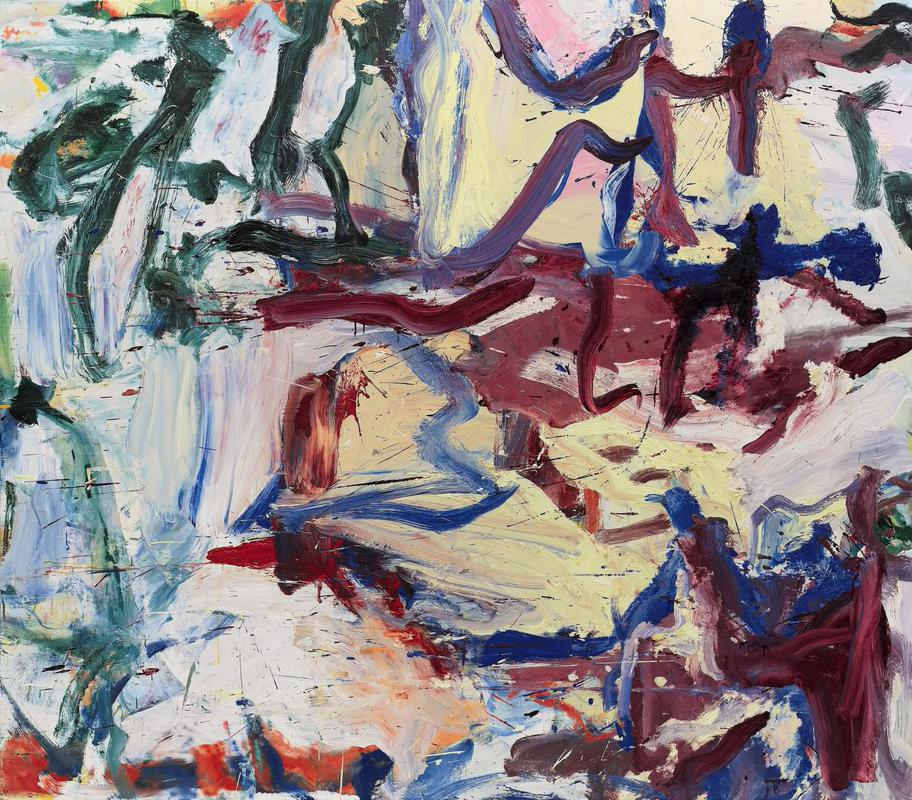More about ...Whose Name Was Writ in Water
- All
- Info
- Shop

Contributor
Aside from women and drinking, Willem de Kooning’s favorite subject was probably water.
Water was easy for an artist like de Kooning to take advantage of—all those crazy brushstrokes and drips and abstract shapes have the “fluid” movement of water and so, you know, if somebody were to ask de Kooning for an artistic interpretation, he could probably just mumble something about the ocean and back away very slowly.
But what about that title? I don’t know about you, but it sounds a little pretentious to me. It turns out it’s a quote from John Keats, a famous poet of British Romanticism (so yes, I standby my calling it pretentious). Although, more than a quote, it’s actually printed on Keats’s tombstone. In 1960, while de Kooning was drunkenly gallivanting around Rome, he stumbled upon a cemetery, saw Keats’s grave, read his epitaph and thought, “Yes, yes, I get you, Keats” and then waited fifteen years before remembering it ever happened and painting ...Whose Name Was Writ in Water.
The story of John Keats is a sad one. Dying at the young age of twenty-five, it seemed Keats’s entire family was cursed with tuberculosis (an illness which has plagued the lives of many artists and their families). Keats had cared for his mother until she died from it eight years prior to Keats’s younger brother Tom also dying from it, and many years after Keats himself would die from it, his older brother George would, yes, you guessed it, also die from tuberculosis. It is strongly believed Keats contracted the illness while taking care of his brother Tom. The irony is painful.
When Keats began coughing one night, a year before his death, he had his roommate bring him a candle so he could inspect the stains he had made on his bed sheets. Traumatized by almost a decade of TB killing his family, he said darkly: “I know the color of that blood...I cannot be deceived in that color—that drop of blood is my death warrant—I must die.” Let’s all take a moment to be grateful this guy wasn’t our roommate.
The epitaph which Keats insisted on having was “Here lies One Whose Name was writ in Water.” Some believe it was a bitter protest against the cruelty of fate, for Keats never believed he would live long enough to establish himself prominently (and therefore his name would fade away like water, instead of being etched in stone). Others believe it was a spiritual or transcendental stance, that Keats was paying respects to life’s impermanence, suggesting all names of all people are “writ in water,” fated to wash away eventually.
Whatever the reason, his friends didn’t like it very much, and so they amended the epitaph slightly: “This grave contains all that was Mortal of a Young English Poet Who on his Death Bed, in the Bitterness of his Heart at the Malicious Power of his Enemies Desired these Words to be engraven on his Tomb Stone: Here lies One Whose Name was writ in Water.” They believed Keats was a cynic, embittered by critics who, not long before Keats succumbed to his illness, had written harsh reviews of his latest works. Or maybe they just didn’t like being reminded of their own impermanence.
Either way, de Kooning thought it was pretty rad. If there is anything we can make out in ...Whose Name Was Writ in Water, it is possibly a few letters of de Kooning’s name, a D, a K, maybe a W somewhere in there, sprawled over the work, the painter’s own name getting washed away, too.
Sources
- Alsdorf, Bridget. “...Whose Name Was Writ in Water.” www.guggenheim.org. Accessed January 28, 2018. https://www.guggenheim.org/artwork/997
- Poets’ Graves Editors. “John Keats.” www.poetsgraves.co.uk. Accessed January 28, 2018. http://www.poetsgraves.co.uk/keats.htm
- Stacey, Michelle. “Writ in Water.” www.theparisreview.org. Accessed January 28, 2018. https://www.theparisreview.org/blog/2016/02/23/writ-in-water/
- Waid, Candace. The Signifying Eye: Seeing Faulkner’s Art. Athens: University of Georgia Press, 2015.












